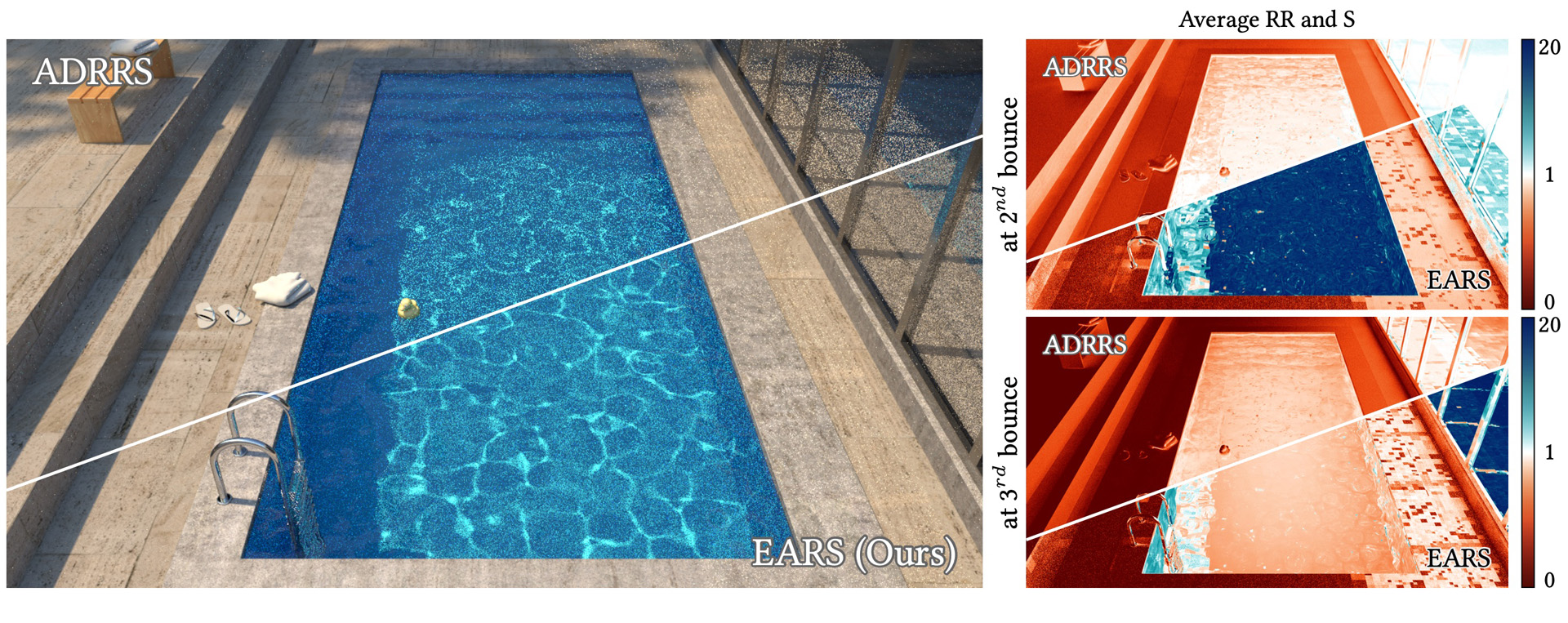“EARS: efficiency-aware russian roulette and splitting” by Rath, Grittmann, Herholz, Weier and Slusallek
Conference:
Type(s):
Title:
- EARS: efficiency-aware russian roulette and splitting
Presenter(s)/Author(s):
Abstract:
Russian roulette and splitting are widely used techniques to increase the efficiency of Monte Carlo estimators. But, despite their popularity, there is little work on how to best apply them. Most existing approaches rely on simple heuristics based on, e.g., surface albedo and roughness. Their efficiency often hinges on user-controlled parameters. We instead iteratively learn optimal Russian roulette and splitting factors during rendering, using a simple and lightweight data structure. Given perfect estimates of variance and cost, our fixed-point iteration provably converges to the optimal Russian roulette and splitting factors that maximize the rendering efficiency. In our application to unidirectional path tracing, we achieve consistent and significant speed-ups over the state of the art.
References:
1. Attila T. Áfra. 2019. Intel® Open Image Denoise. https://www.openimagedenoise.org/.Google Scholar
2. James Arvo and David Kirk. 1990. Particle transport and image synthesis. SIGGRAPH ’90, 63–66.Google ScholarDigital Library
3. Stefan Banach. 1922. Sur les opérations dans les ensembles abstraits et leur application aux équations intégrales. Fund. math 3, 1 (1922), 133–181.Google Scholar
4. Vasile Berinde. 2007. Iterative approximation of fixed points. Vol. 1912. Springer.Google Scholar
5. Benedikt Bitterli. 2016. Rendering resources. https://benedikt-bitterli.me/resources/Google Scholar
6. Mark R Bolin and Gary W Meyer. 1997. An error metric for Monte Carlo ray tracing. In Eurographics Workshop on Rendering Techniques. Springer, 57–68.Google ScholarCross Ref
7. Xi Deng, Miloš Hašan, Nathan Carr, Zexiang Xu, and Steve Marschner. 2021. Path graphs: iterative path space filtering. ACM Transactions on Graphics (TOG) 40, 6 (2021), 1–15.Google ScholarDigital Library
8. Iliyan Georgiev, Jaroslav Křivánek, Tomáš Davidovič, and Philipp Slusallek. 2012. Light transport simulation with vertex connection and merging. ACM Trans. Graph. 31, 6 (2012), 192–1.Google ScholarDigital Library
9. Cindy M Goral, Kenneth E Torrance, Donald P Greenberg, and Bennett Battaile. 1984. Modeling the interaction of light between diffuse surfaces. ACM SIGGRAPH computer graphics 18, 3 (1984), 213–222.Google Scholar
10. Pascal Grittmann, Iliyan Georgiev, and Philipp Slusallek. 2021. Correlation-Aware Multiple Importance Sampling for Bidirectional Rendering Algorithms. Comput. Graph. Forum (EG 2021) 40, 2 (2021).Google Scholar
11. Toshiya Hachisuka, Jacopo Pantaleoni, and Henrik Wann Jensen. 2012. A path space extension for robust light transport simulation. ACM Trans. Graph. (TOG) 31, 6 (2012), 191.Google ScholarDigital Library
12. J.M. Hammersley and D.C. Handscomb. 1968. Monte Carlo Methods. Springer, Dordrecht.Google Scholar
13. Sebastian Herholz, Yangyang Zhao, Oskar Elek, Derek Nowrouzezahrai, Hendrik P. A. Lensch, and Jaroslav Křivánek. 2019. Volume Path Guiding Based on Zero-Variance Random Walk Theory. ACM Trans. Graph. 38, 3, Article 25 (June 2019), 19 pages.Google ScholarDigital Library
14. Wenzel Jakob. 2010. Mitsuba renderer. http://www.mitsuba-renderer.org.Google Scholar
15. James T. Kajiya. 1986. The Rendering Equation. SIGGRAPH Comput. Graph. 20, 4 (Aug. 1986), 143–150.Google ScholarDigital Library
16. David Kirk and James Arvo. 1991. Unbiased Sampling Techniques for Image Synthesis. ACM Trans. Graph. (SIGGRAPH ’91) 25, 4 (jul 1991), 153–156. Google ScholarDigital Library
17. Eric P. Lafortune and Yves D. Willems. 1993. Bi-Directional Path Tracing. 93 (Dec. 1993), 145–153.Google Scholar
18. Thomas Müller, Markus H. Gross, and Jan Novák. 2017. Practical Path Guiding for Efficient Light-Transport Simulation. Comput. Graph. Forum 36 (2017), 91–100.Google ScholarDigital Library
19. Matt Pharr, Wenzel Jakob, and Greg Humphreys. 2016. Physically based rendering: From theory to implementation. Morgan Kaufmann.Google Scholar
20. Stefan Popov, Ravi Ramamoorthi, Fredo Durand, and George Drettakis. 2015. Probabilistic Connections for Bidirectional Path Tracing. Comput. Graph. Forum 34, 4 (jul 2015), 75–86.Google Scholar
21. Alexander Rath, Pascal Grittmann, Sebastian Herholz, Philippe Weier, and Philipp Slusallek. 2022. Implementation of EARS: Efficiency-Aware Russian Roulette and Splitting. Google ScholarCross Ref
22. Mateu Sbert, Vlastimil Havran, and László Szirmay-Kalos. 2019. Optimal Deterministic Mixture Sampling.. In Eurographics (Short Papers). 73–76.Google Scholar
23. László Szirmay-Kalos. 2005. Go with the winners strategy in path tracing. © Journal of WSCG, 2005, vol. 13, núm. 1–3, p. 49–56 (2005).Google Scholar
24. László Szécsi, László Szirmay-Kalos, and Csaba Kelemen. 2003. Variance Reduction for Russian-roulette.Google Scholar
25. Eric Veach. 1997. Robust Monte Carlo methods for light transport simulation. Stanford University PhD thesis.Google ScholarDigital Library
26. Eric Veach and Leonidas Guibas. 1995a. Bidirectional estimators for light transport. In Photorealistic Rendering Techniques. Springer, 145–167.Google Scholar
27. Eric Veach and Leonidas J Guibas. 1995b. Optimally Combining Sampling Techniques for Monte Carlo Rendering. In SIGGRAPH ’95. ACM, 419–428.Google Scholar
28. Jiří Vorba, Ondřej Karlík, Martin Šik, Tobias Ritschel, and Jaroslav Křivánek. 2014. On-line Learning of Parametric Mixture Models for Light Transport Simulation. ACM Trans. Graph. (Proceedings of SIGGRAPH 2014) 33, 4 (2014).Google Scholar
29. Jiří Vorba and Jaroslav Křivánek. 2016. Adjoint-driven Russian Roulette and Splitting in Light Transport Simulation. ACM Trans. Graph. 35, 4, Article 42 (July 2016), 11 pages. Google ScholarDigital Library
30. Matthias Zwicker, Wojciech Jarosz, Jaakko Lehtinen, Bochang Moon, Ravi Ramamoorthi, Fabrice Rousselle, Pradeep Sen, Cyril Soler, and S-E Yoon. 2015. Recent advances in adaptive sampling and reconstruction for Monte Carlo rendering. In Computer graphics forum, Vol. 34. Wiley Online Library, 667–681.Google ScholarDigital Library





